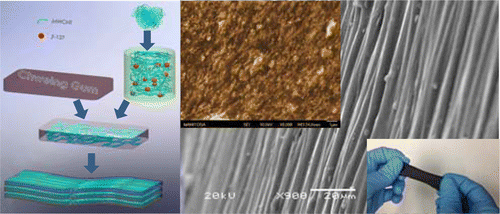New stretchable, wearable sensor made with chewing gum

Body sensors, which were once restricted to doctors' offices, have come a long way. They now allow any wearer to easily track heart rate, steps and sleep cycles around the clock. Soon, they could become even more versatile—with the help of chewing gum. Scientists report in the journal ACS Applied Materials & Interfaces a unique sensing device made of gum and carbon nanotubes that can move with your most bendable parts and track your breathing.
Most conventional sensors today are very sensitive and detect the slightest movement, but many are made out of metal. That means when they're twisted or pulled too much, they stop working. But for sensors to monitor the full range of a body's bending and stretching, they need a lot more give. To meet that need, some researchers have tried developing sensors using stretchy plastics and silicones. But what they gained in flexibility, they lost in sensitivity. Malcolm Xing and colleagues found a better solution right under their noses—and in their mouths.
To make their supple sensor, a team member chewed a typical piece of gum for 30 minutes, washed it with ethanol and let it sit overnight. The researchers then added a solution of carbon nanotubes, the sensing material. Simple pulling and folding coaxed the tubes to align properly. Human finger-bending and head-turning tests showed the material could keep working with high sensitivity even when strained 530 percent. The sensor also could detect humidity changes, a feature that could be used to track breathing, which releases water vapor with every exhale.
More information: Mohammad Ali Darabi et al. Gum Sensor: A Stretchable, Wearable, and Foldable Sensor Based on Carbon Nanotube/Chewing Gum Membrane, ACS Applied Materials & Interfaces (2015). DOI: 10.1021/acsami.5b08276
Abstract
Presented in this work is a novel and facile approach to fabricate an elastic, attachable, and cost-efficient carbon nanotube (CNT)-based strain gauge which can be efficiently used as bodily motion sensors. An innovative and unique method is introduced to align CNTs without external excitations or any complicated procedure. In this design, CNTs are aligned and distributed uniformly on the entire chewing gum by multiple stretching and folding technique. The current sensor is demonstrated to be a linear strain sensor for at least strains up to 200% and can detect strains as high as 530% with a high sensitivity ranging from 12 to 25 and high durability. The gum sensor has been used as bodily motion sensors, and outstanding results are achieved; the sensitivity is quite high, capable of tracing slow breathing. Since the gum sensor can be patterned into various forms, it has wide applications in miniaturized sensors and biochips. Interestingly, we revealed that our gum sensor has the ability to monitor humidity changes with high sensitivity and fast resistance response capable of monitoring human breathing.
Journal information: ACS Applied Materials and Interfaces
Provided by American Chemical Society




















